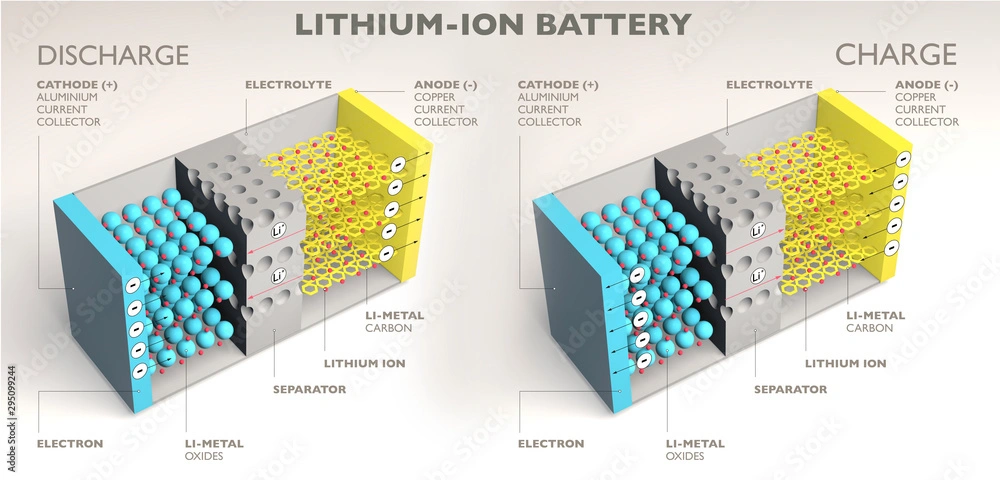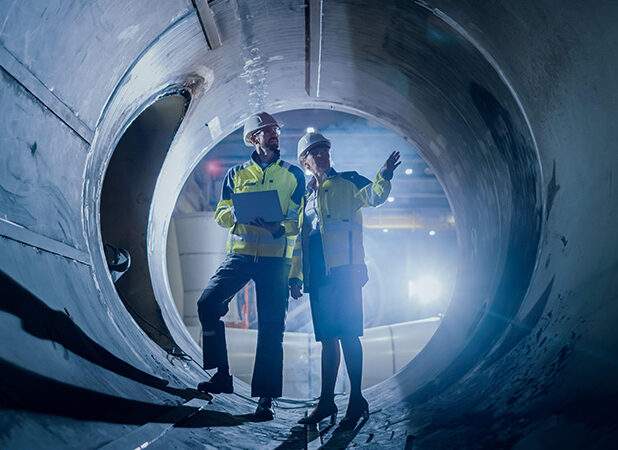Introduction
Lithium-ion batteries have transformed energy storage, especially in renewable energy systems and electric vehicles (EVs). Their high energy density and long cycle life makes them essential for improving the sustainability and efficiency of modern energy solutions.
Understanding Lithium-Ion Batteries

Graphic showing the discharge and charging stages of a lithium-iron battery. Source.
Composition
They are rechargeable and use lithium ions that move from the negative electrode (anode) to the positive electrode (cathode) during discharge and back during charging. The electrodes are usually made of materials such as lithium cobalt oxide, lithium manganese oxide, or lithium iron phosphate.
High Energy Density
Lithium-ion batteries are known for their high energy density, which allows for a significant amount of energy to be stored in a compact and lightweight design. This makes them ideal for applications where space and weight are important factors, such as in electric vehicles.
Long Cycle Life
These batteries hey can undergo many charge and discharge cycles before experiencing a significant decline in performance. This durability contributes to the sustainability and cost-effectiveness of energy storage systems and electric vehicles.
Applications in Renewable Energy Storage
Grid-Level Storage
Lithium-ion batteries are becoming more commonly used for energy storage on the grid. They are essential for storing surplus energy produced by renewable sources, like solar or wind power, for later use during peak demand or when renewable generation is low.
Residential Energy Storage:
Lithium-ion batteries are integrated into energy storage systems in residential settings, enabling homeowners to store excess energy generated by solar panels. Low solar production or power outages call for the use of this stored energy.
Powering Electric Vehicles
Mainstay in Electric Mobility
Lithium-ion batteries are the primary energy storage technology used in electric vehicles. Their high energy density allows EVs to travel longer distances between charges, making them a reliable and practical option for electric mobility.
Advancements in EV Technology:
Ongoing research and development in lithium-ion battery technology is driving advancements in electric vehicle capabilities. Innovations focus on enhancing energy density, reducing charging times, and improving overall battery performance to meet the evolving demands of the automotive industry.
Sustainable Future with Lithium-Ion Batteries
Reducing Carbon Footprint
The adoption of lithium-ion batteries significantly reduces carbon emissions, particularly when integrated into renewable energy and electric vehicle systems. These batteries enable cleaner and more efficient energy storage and transportation, playing a vital role in fostering a sustainable future.
Continued Advancements
Lithium-ion batteries will continue evolving as technology advances. Ongoing research aims to address challenges such as the availability of raw materials, recycling methods, and the development of even more efficient and sustainable battery chemistries.
Conclusion
Lithium-ion batteries are leading the energy revolution by driving the transition towards cleaner, more sustainable energy solutions. They are versatile and efficient, making them a key player in shaping the future of energy storage and transportation. They power electric vehicles and store renewable energy at the grid level.
Frequently asked questions
How do lithium-ion batteries work?
They function by enabling lithium ions to move between the negative (anode) and positive (cathode) electrodes during discharge and charging, generating electrical energy. The electrodes are usually made of materials such as lithium cobalt oxide, lithium manganese oxide, or lithium iron phosphate.
What makes lithium-ion batteries suitable for electric vehicles?
Their high energy density is the main factor. This characteristic enables them to store a significant amount of energy in a compact and lightweight design, providing the long-range capabilities required for electric mobility. Additionally, their long cycle life enhances the durability and sustainability of electric vehicles.
How are lithium-ion batteries used in renewable energy storage?
They store excess energy generated by renewable sources, such as solar or wind power, ensuring a reliable power supply during peak demand or when renewable generation is low.






